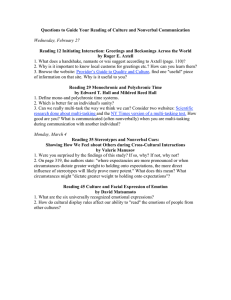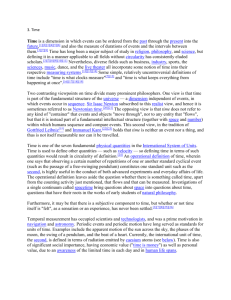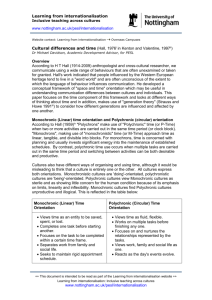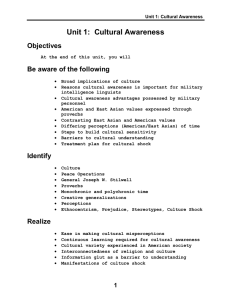The role of culture in conflict management and negotiations
advertisement
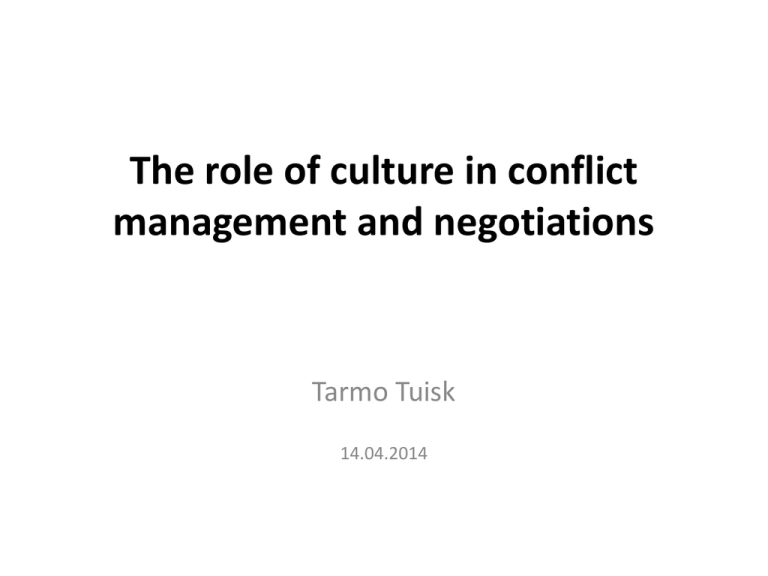
The role of culture in conflict management and negotiations Tarmo Tuisk 14.04.2014 Understanding cultural differences (Hall & Hall, 1990) • Even though culture is perceived personally, it is nonetheless a shared system. • As culture is experienced personally, very few individuals see for what it is – a program of behaviour. • Members of a common culture not only share information, but also methods of coding, storing and retrieving of that information. • These methods vary from culture to culture. 2 Understanding cultural differences • Knowing what kind of information people from other cultures require is one key to effective international communication. • “Hidden codes” of behaviour need “code breaker” to be understood. • 90% or more of all communication is in culture’s nonverbal messages (i.e. not language). 3 Culture is communication - Each cultural world operates according to its own internal dynamic, principles and laws (written & unwritten), also time and space. - But common for each culture are: words, material things and behaviour. - Words: medium of business, politics and diplomacy - Material things: indicators of status and power - Behaviour: feedback about people feel and includes techniques to avoid confrontation. 4 “Silent language” • …human behaviour that exists outside conscious awareness. • …includes evolutionary concepts, practices, solutions to problems, shared experience of ordinary people. • “Provides insights into the underlying principles that shape our lives.” • These principles are not merely interesting, but eminently practical. 5 Fast and slow messages • Cross-cultural communication has more to do with releasing right responses than sending “right” messages • Information can be sent in different speed • A fast message to them who have used to have it in slow format will miss the target; • Although people can understand the content of wrong-speed message, for them who expect it in different speed it won’t be understandable. • People are not (always) aware that the information can be sent in different speeds. 6 7 Fast and Slow Messages • Almost everything in life can be placed somewhere within fast/slow message spectrum. • Slow mode: research, diplomacy, writing books, creating art. • Messages of Buddha, Confucius, Goethe, Rembrandt are still now - hundreads of years after the fact – under deciphering by human beings. • Very slow messages: a person, a language, and culture – incorporating multiple styles of “languages” where messages are released for them who are willing to spend time to understand it. 8 High and Low Context • Context – the information that surrounds the event. • The elements that combine to produce a given meaning – events and context – are in different proportions depending on the culture. • High context (HC) communication or message is the one where most of the information is already on the person, and very little is in the coded, explicit, transmitted part of the message (e.g. twins communicating with each other). • Low context (LC) – the mass of the information is vested in the explicit code (e.g. two lawyers in the courtroom during a trial). 9 HC people and LC people HC people: Japanese, Arabs, Mediterranean. (having extensive information networks among family, friends, colleagues, clients. Beacuse of daily information exchange their messages are highcontext). LC people: Americans, Swiss, Germans, Scandinavians, other Northern Europeans. Example: The French are much higher on the context scale than either Germans or Americans. 10 Space • Territoriality – e.g. what is “mine” for Germans is not percieved the same way for Americans (e.g. touching a car..). • Space communicates power (e.g. location of the boss in the office). • Personal Space – a “bubble” around a person (North vs. South) • Unconsious Reactions to Spatial Differences 11 Time Monochronic and Polychronic Time Monochronic – paying attention and doing only one thing at a time. Time is experianced and used in a linear way. Perceived as tangible: “spent”, “wasted”, “saved” and “lost”. Polychronic – simultaneus occurance of many things by great involvement of people. More emphasis on completing human actions than meeting the schedules. 12 13 14 Relation between Time and Space MT culture: emphasis is on the compartmentalization of functions and people (e.g. private offices are soundproof). PT culture: business offices with large reception areas; polychronic people feel that private space disrupts the flow of information; appointments mean very little and may be shifted around at the last minute in the sake of someone who is more important in individual’s hierarchy of family, friends or associates. NB! Monocrhonic vs Polychronic Time culture – this dichotomy cannot be overemphasizied. 15 Time as Communication Tempo, Rhythm, Synchrony: • (e.g. Americans complain: Germans take forever to reach decisions) • There is a need to be contexted to local time system. Scheduling and Lead Time USA and Germany: schedules are sacred. Short lead time means the business is less important (e.g. two weeks minimum) 16 The Importance of Proper Timing • Announcements of major changes must be carefully timed. • USA and northern Europe: anything that occurs outside business hours refers to ‘emergency’. • E.g. in August in France everything shuts down for vacances. • Common in US: short lunch vs. longer dinner in France to get acquinted with business partners. 17 Appointments • Waiting-time: in the U.S. and Germany – delibarate putdown and/or a message about the individual being very disorganized • In France: no such message is intended. • Interactions between monochronic and polychronic people can be stressful unless both parties know and decode the meanings behind each other’s language and time. 18 Information Flow: Fast and Slow What should be known about foreign culture? How information is handled: 1) Where it goes and whether it flows easily through the society and the organisation? 2) Whether it is restricted to narrow channels because of compartmentalization? HC countries – information flows freely wherever people are spatially involved. Emphasis is on stored rather than on transmitted information. 19 Action Chains: The importance of completition • Monochronic low-context cultures: compartmentized approach and dependence on schedules are more sensitive to interrputions, and more vulnarable to the breaking of action chains compared to highcontext cultures. • High-context people are more elastic because of their extensive and cohesive networks in their system. 20 Action chains and disputes • All cultures have in-built safeguards to prevent a dispute from escalating. • These safeguards apply only within the context of one’s own culture. • In foreign situation where a dispute appears imminent it is essential to do two things: 1) Proceed slowly, taking every action possible to maintain course; 2) Seek the advice of a skillful, tactful interpreter of the culture – a mediator. 21 Interfacing: Creating the Proper Fit It is more difficult to succeed in a foreign country than at home. The higher the context of the culture or the organisation, the more difficult to interface. The greater the cultural distance, the more difficult to interface. The greater the number of levels in the system, the more difficult to interface. (e.g. Germany-Switzerland industry of technical details vs. France-USA newspaper publishing). 22 Situations • Situational frames and situational dialects • ‘Situational dialects’ are used in ‘situational frames’ • High-context situational dialect: communication between pilots and controltower. • Speak to people in their own language, but in situations in which they are familiar. 23 Summary • Speed of messages • Context • Space • Time • Information flow • Action chains • Interfacing All these are involved in the creation of both national and corporate character. In cultural context all acts, all events and all material things have meaning. 24 Literature • Hall, E. T., Hall, M. R. (1990). Understanding Cultural Differences. Intercultural Press. • Hall, E. T. (1973/1990). The Silent Language. Anchor Books Editions : New York • Hall, E. T. (1977/1989). Beyond Culture. Anchor Books Editions : New York. 25

